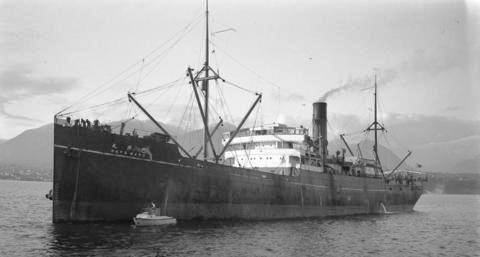RIKUGUN YUSOSEN
 (HAYO MARU, prewar)
(HAYO MARU, prewar)
HAYO MARU:
Tabular Record of Movement
© 2013-2016 Bob Hackett
12 May 1920:
Tsurumi, Yokohama. Laid down at Asano Zosensho K. K., as yard
number 37, a 5,446-ton cargo ship for Toyo Kisen Kaisha (Oriental Steamship
Company), Yokohama.
12 December 1920:
Launched and named HAYO MARU.
3 March 1921:
Completed.
1921-1941:
In service on Oriental Steamship Co’s routes.
25 September 1922:
N Atlantic. HAYO MARU damages her rudder due to
unknown causes. Her captain sends out an SOS. The SOS is received by American
steamer RESOLUTE en route from New York to Plymouth, England. RESOLUTE offers to
take off HAYO MARU’s crew, but her captain is unwilling to abandon ship.
Subsequently, the rudder is repaired and she proceeds.
16 January 1923:
Arrives at Ellis Island, New York from Huelva, Spain.
13 April 1923:
Tsurumi.Docked at Asano shipyard for routine maintenance.
20 August 1923:
Arrives at Ellis Island from Hong Kong.
9 February 1923:
Arrives at Ellis Island from Yokohama.
14 February 1932:
16 miles N of Bunbury, S of Perth, SW Australia.
HAYO MARU bound from Bunbury to Fremantle to complete loading a cargo of wheat
runs aground on a sandbank.
15 February 1932:
Tug UCO arrives at the scene followed at 0800 the
next day by Western Australia State Government's motor vessel KYBRA from
Fremantle. The Japanese lighter 3,000 bags totaling 250 tons from HAYO to KYBRA.
22 February 1932:
HAYO MARU’s crew quickly dumps overboard thousands
of pounds of bagged wheat to lighten the ship. UCO and KYBRA attach towlines and
pull HAYO MARU off the sandbank into deep water at 1120. By 1330, she has
sufficient steam to go to Bunbury under her own power.
23 September 1941:
Requisitioned by the Imperial Army as a troop
transport. Alloted Army No. 124.
18 December 1941: The Invasion of the Philippines -“M” Operation (M
Sakusen):
At 1700, HAYO MARU departs Takao for Lingayen Gulf, Philippines in
Rear Admiral (later Vice Admiral) Rear Admiral Hara Kensaburo's (37)(former CO
of TAKAO) 1st Lingayen Invasion Unit with 26 other IJA transports escorted by
DesRon 5's light cruiser NATORI, DesDiv 5's ASAKAZE, HARUKAZE and MATSUKAZE,
DesDiv 22's FUMIZUKI, MINAZUKI, NAGATSUKI and SATSUKI, minesweepers W-15 and W-16 and subchasers CH-1, CH-2, CH-3 CH-13, CH-14 and CH-15. HAYO MARU carries elements of the IJA 48th Division and the 4th Field Hospital.
The Japanese main invasion at Lingayen Gulf consists of three transport
echelons and carries the main part of LtGen Homma Masaharu's 80,000-man 14th
Army. The first echelon is composed of 27 transports from Takao under Rear
Admiral Hara , the second echelon of 28 transports under Rear Admiral (later
Vice Admiral) Nishimura Shoji (39) and the third echelon of 21 transports from
Keelung under Rear Admiral (later Vice Admiral) Hirose Sueto (39).
21 December 1941:
Ngaen Bay, Lingayen. LtCdr Wreford G. Chapple’s
(USNA ‘27) USS S-38 (SS-143) receives orders to penetrate shallow Lingayen Gulf
and attack enemy shipping. S-38 enters the gulf just before dawn. S-38’s crew
sights a convoy of four transports escorted by two destroyers.
0710, Chapple fires four bow tubes, but all misses. At 0758, he launches
two torpedoes at an anchored cargo ship. HAYO MARU blows up, splits in two and
sinks at 16-37N, 120-17E. All troops of the 48th Division had already been put ashore,
but the 4th Field Hospital's equipment is lost and two crewmen are KIA.
Destroyers close the submarine, and Chapple puts S-38 on the shallow 80
foot (24 m) bottom. S-38 lay doggo as depth charges are dropped, but none close.
From 0804 to 0930, S-38 ran silent, using evasive maneuvers s. At 0930, the
submarine runs aground on the bottom. She remains there most of the day.
Overhead, destroyers and small boats continue to search, but without success. At
2130, S-38 tries to clear by backing, but her port propeller is damaged. Nevertheless,
by 2201, she is free and underway out of the area.
Author's Note:
Thanks go to Erich Muehlthaler of Germany.
Bob Hackett
Back
to IJA Transports





